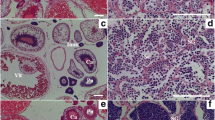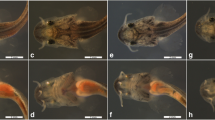Abstract
We have compared various properties of spermatozoa from the wild diploid male pond loach Misgurnus anguillicaudatus to those from the interspecific male hybrid of the cross between a female M. anguillicaudatus and a male mud loach M. mizolepis. Our results show that spermatozoa from this interspecific hybrid had poor motility, low viability, abnormal morphology, a larger volume of mitochondrial mass per cell and higher ATP content of spermatozoa with tetraploid DNA content, and they were present at a low concentration. The interspecific hybrid males produced spermatozoa with a larger head, with either no flagellum (36.4 %), one flagellum (46.7 %) or two flagella (16.9 %). These flagella were shorter than those of the normal wild-type male M. anguillicaudatus and often presented with abnormalities in microtubule structure. An abnormally shorter flagellum has difficulty in propelling tetraploid spermatozoa with an increased head size in normal progressive motility, although they had higher energy, as shown by their larger volume of mitochondrial mass and higher ATP content. These tetraploid spermatozoa are likely produced by the arrest of the regular meiotic division after chromosomal replication, followed by abnormal spermiogenesis.








Similar content being viewed by others
References
Suzuki R, Fukuda Y (1973) Sexual maturity of F1 hybrids among salmonid fishes. Bull Freshw Fish Res Lab 23:57–74
Suzuki R (1974) Inter-crossing and back-crossing of F1 hybrids among salmonid fishes. Bull Freshw Fish Res Lab 24:11–31
Chevassus B (1983) Hybridization in fish. Aquaculture 17:113–128
Senanan W, Kapuscinski AR, Na-Nakorn U, Miller LM (2004) Genetic impacts of hybrid catfish farming (Clarias macrocephalus x C. gariepinus) on native catfish populations in central Thailand. Aquaculture 235:157–184
Pandian TJ (2011) Sex determination in fish. Science Publishers, Enfield/CRC Press, Boca Raton
Johnson KR, Wright JE (1986) Female brown trout x Atlantic salmon hybrids produce gynogens and triploids when backcrossed to male Atlantic salmon. Aquaculture 57:345–358
Dawley RM (1989) An introduction to unisexual vertebrates. In: Dawley RM, Bogart JP (eds) Evolution and ecology of unisexual vertebrates. New York State Museum, Albany, pp 1–18
Arai K, Fujimoto T (2013) Genomic constitution and atypical reproduction in polyploid and unisexual lineages of the Misgurnus loach, a teleost fish. Cytogenet Genome Res 140:226–240
Kimura-Kawaguchi M, Horita M, Abe S, Arai K, Kawata M, Munehara H (2014) Identification of hemiclonal reproduction in three species of Hexagrammos marine reef fishes. J Fish Biol 85:189–209
Alves MJ, Coelho MM, Prospero MI, Collares-Pereira MJ (1999) Production of fertile unreduced sperm by hybrid males of the Rutilus alburnoides complex (Teleostei, Cyprinidae): an alternative route to genome tetraploidization in unisexuals. Genetics 151:277–283
Cherfas NB, Gomelsky BI, Emelyanova OV, Recoubratsky AV (1994) Induced diploid gynogenesis and polyploidy in crucian carp, Carassius auratus gibelio (Bloch), x common carp, Cyprinus carpio L., hybrids. Aquac Res 25:943–954
Liu S, Liu Y, Zhou G, Zhang X, Luo C, Feng H, He X, Zhu G, Yang H (2001) The formation of tetraploid stocks of red crucian carp × common carp hybrids as an effect of interspecific hybridization. Aquaculture 192:171–186
Sun Y, Zhang C, Liu S, Duan W, Liu Y (2007) Induced interspecific androgenesis using diploid sperm from allotetraploid hybrids of common carp × red crucian carp. Aquaculture 264:47–53
Yoshikawa H, Morishima K, Kusuda S, Yamaha E, Arai K (2007) Diploid sperm produced by artificially sex-reversed clone loaches. J Exp Zool 307A:75–83
Yoshikawa H, Morishima K, Fujimoto T, Saito T, Kobayashi T, Yamaha E, Arai K (2009) Chromosome doubling in early spermatogonia produces diploid spermatozoa in a natural clonal fish. Biol Reprod 80:973–979
Fujita T (2007) Scientific name for the loach “Kara-Dojo” distributed in Japan. Jpn J Ichthyol 54:243–244 (in Japanese)
Chen IS, Chang YC (2005) A photographic guide to the inland-water fishes of Taiwan. Vol. 1: Cyprinifromes. The Suei Chan Press, Keelung, Taiwan (in Chinese)
Perdices A, Vasil’ev V, Vasil’eva E (2011) Molecular phylogeny and intraspecific structure of loaches (genera Cobitis and Misgurnus) from the Far East region of Russia and some conclusions on their systematics. Ichthyol Res 59:1–11
Ojima Y, Hitotsumachi S (1969) Cytogenetical studies in loaches (Pisces, Cobitidae). Japan Zool Mag 78:139–141 (in Japanese with English summary)
Kim DS, Nam YK, Park IS (1995) Survival and karyological analysis of reciprocal diploid and triploid hybrids between mud loach (Misgurnus mizolepis) and cyprinid loach (Misgurnus anguillicaudatus). Aquaculture 135:257–265
Park IS, Nam YK, Kim DS (2006) Growth performance, morphometric traits and gonad development of induced reciprocal diploid and triploid hybrids between the mud loach (Misgurnus mizolepis Günther) and cyprinid loach (Misgrunus anguillicaudatus Cantor). Aquac Res 37:1246–1253
Fujimoto T, Yasui GS, Yoshikawa H, Yamaha E, Arai K (2008) Genetic and reproductive potential of spermatozoa of diploid and triploid males obtained from interspecific hybridization of Misgurnus anguillicaudatus female with M. mizolepis male. J Appl Ichthyol 24:430–437
Zhao Y, Pšenička M, Fujimoto T, Saito T, Yasui GS, Yamaha E, Arai K (2012) Motility, morphology, mitochondria and ATP content of diploid spermatozoa from sex-reversed clonal diploid and neo-tetraploid loach, Misgurnus anguillicaudatus. J Appl Ichthyol 28:1006–1012
Zhao Y, Saito T, Pšenička M, Fujimoto T, Arai K (2014) Comparison of spermatozoa parameters, fine structures, and energy-related factors among tetraploid, hyper-tetraploid, and hyper-triploid loaches (Misgurnus anguillicaudatus). J Exp Zool Part A Ecol Genet Physiol 321:198–206
Zhao Y, Toda M, Hou JL, Aso M, Arai K (2012) The occurrence of hypertetraploid and other unusual polyploid loaches Misgurnus anguillicaudatus among market specimens in Japan. Fish Sci 78:1219–1227
Kurokura H, Hirano R, Tomita M, Iwahashi M (1984) Cryopreservation of carp sperm. Aquaculture 37:267–273
Yasui GS, Arias-Rodriguez L, Fujimoto T, Arai K (2009) A sperm cryopreservation protocol for the loach Misgurnus anguillicaudatus and its applicability for other related species. Anim Reprod Sci 116:335–345
Iwamatsu T, Ishijima S, Nakashima S (1993) Movement of spermatozoa and changes in micropyles durind fertilization in medaka eggs. J Exp Zool 266:57–64
Poot M, Zhang YZ, Kramer JA, Wells KS, Lj Jones, Hanzel DK, Lugade AG, Singer VL, Haugland RP (1996) Analysis of mitochondrial morphology and function with novel fixable fluorescent stains. J Histochem Cytochem 44:1363–1372
Métivier D, Dallaporta B, Zamzami N, Larochette N, Susin SA, Marzo I, Kroemer G (1998) Cytofluorometric detection of mitochondrial alterations in early CD95/Fas/APO-1-triggered apoptosis of Jurkat T lymphoma cells. Comparison of seven mitochondrion-specific fluorochromes. Immunol Lett 61:157–163
Shimizu Y, Shibata N, Yamashita M (1997) Spermiogenesis without preceding meiosis in the hybrid medaka between Oryzias latipes and O. curvinotus. J Exp Zool 279:102–112
Cosson J (2008) The motility apparatus of fish spermatozoa. In: Alavi SMH, Cosson JJ, Coward K, Rafiee C (eds) Fish spermatology. Alpha Science International Ltd, Oxford, pp 281–316
Acknowledgments
This work was supported in part by Grants-in-Aid from JSPS-KAKENHI (grant no. 21380114) and JAMBIO (grant nos. 23-11 and 24-11) to KA and TF; grants from Youth Scholars of Shanghai Higher Education Institutions–China (grant no. A1-2035-14-0010-9) and the Doctoral Fund (grant no. A1-0209-13-0105390) to YZ; grants from the Ministry of Education, Youth and Sports of the Czech Republic (projects “CENAKVA”; grant no. CZ.1.05/2.1.00/01.0024 and “CENAKVA II”, LO1205 under the NPU I program) to MP.
Author information
Authors and Affiliations
Corresponding author
Rights and permissions
About this article
Cite this article
Zhao, Y., Fujimoto, T., Pšenička, M. et al. Non-motile tetraploid spermatozoa of Misgurnus loach hybrids. Fish Sci 82, 127–135 (2016). https://doi.org/10.1007/s12562-015-0939-7
Received:
Accepted:
Published:
Issue Date:
DOI: https://doi.org/10.1007/s12562-015-0939-7




